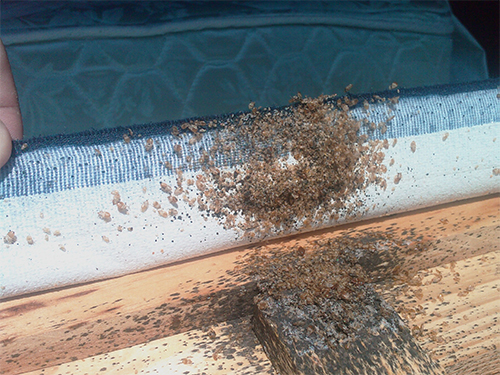Check Out the Various Kinds Of Bug and Their Therapy Choices for Effective Monitoring
The monitoring of pests in both agricultural and domestic settings demands a comprehensive understanding of the various types that can invade these environments, along with the treatment options readily available for reliable control. From family rodents that pose health and wellness dangers to garden pests that endanger plant returns, each classification demands a customized technique. Comprehending the subtleties of bug habits and the corresponding remedies is critical; nevertheless, the question remains: what are one of the most effective strategies that not only deal with existing invasions but likewise prevent future occurrences?

Typical Household Pests
Although house insects can differ considerably in kind and actions, numerous share typical characteristics that make them a hassle. Usual house pests consist of rats such as rats and mice, insects like roaches and ants, and periodic intruders such as spiders and flies. These pests usually grow in settings that offer very easy accessibility to sanctuary, water, and food, making homes particularly vulnerable.
Rodents, for circumstances, are well-known for causing structural damage and spreading condition. Bugs like cockroaches are not only disturbing but can additionally set off allergic reactions and bronchial asthma in delicate people.
Reliable insect monitoring begins with avoidance, which consists of sealing entrance points, keeping cleanliness, and using proper storage space approaches for food. Recognizing the behaviors and qualities of these common house insects is crucial for reliable administration and keeping a healthy and balanced living setting.
Garden Insects and Their Influence
Yard insects position a significant threat to the wellness and performance of plants, with some estimates suggesting that they can create up to 40% of plant losses in particular regions. These bugs, that include pests such as beetles, aphids, and caterpillars, along with nematodes, can inflict serious damages by feeding upon plant tissues, causing stunted growth, lowered yields, and jeopardized quality.
The effect of yard bugs extends past simple visual issues; they can disrupt ecological communities by changing food chains, influencing pollinators, and spreading out diseases among plants. For instance, parasites like the crawler mite can damage plants, making them a lot more at risk to fungal infections. Invasive types might outcompete indigenous vegetation, leading to biodiversity loss.
Effective monitoring strategies are vital to mitigate these hazards. Integrated Bug Monitoring (IPM) techniques, which integrate organic control, cultural methods, and targeted chemical applications, can give sustainable options. Regular monitoring and early treatment are important in preventing infestations. bed bug heat treatment. By comprehending the specific pests and their actions, gardeners can implement targeted therapies that not just secure their plants however also promote a much healthier yard ecological community.
Rats: Identification and Dangers
Rodents are typical garden insects that can present significant risks to plant health and wellness and overall environment stability. These tiny creatures, including varieties such as voles, rats, and computer mice, are usually identified by their sharp incisor teeth and durable bodies. Their hair website link coloration differs widely, ranging from grey to brownish, and they usually show a lengthy tail which help in balance and dexterity.
The threats connected with rodent infestations are complex. Rodents are well-known for their role as vectors of various illness, including hantavirus and leptospirosis, which can be transmitted to pets and human Full Report beings.
In addition, rodents can interrupt the all-natural balance of regional communities by contending with indigenous wildlife for resources. Their tunneling behaviors can result in dirt disintegration and destabilization of plant roots. As a result, early recognition and understanding of rodent actions and risks are crucial for efficient bug management.
Efficient Therapy Approaches
When taking care of rodent invasions, employing effective therapy methods is crucial for reducing damages and wellness dangers. Snap traps and digital traps supply a humane and fast means to remove rodents, while glue catches can help keep an eye on activity levels.
Second of all, lure terminals including rodenticides can be purposefully positioned in areas of high rodent task. These terminals ought to be tamper-resistant to ensure the safety and security of non-target pets and children. It is important to choose the ideal bait type, as rodents can create bait hostility if not transformed occasionally.
In addition to traps and bait, securing entrance points can substantially lower the opportunities of re-infestation. This entails inspecting and fixing gaps in walls, doors, and home windows.
Lastly, expert parasite control solutions can be beneficial for substantial invasions. They have the knowledge, devices, and items essential for effective elimination and can develop a tailored management plan. By applying these therapy methods, property owners can effectively deal with rodent issues and protect their health and property.
Preventative Steps and Tips

Preserving cleanliness is just as important; guarantee that food is kept in closed containers and quickly clean up spills or crumbs. On a regular basis dealing with waste and making certain that compost heap are taken care of correctly can deter parasites from being drawn in to your home.
Furthermore, think about landscape design methods that dissuade rodent habitation. Trim plants and keep mulch far from the foundation of your residential or commercial property, as these can provide concealing places for bugs.
Conclusion
Effective parasite monitoring requires a comprehensive understanding of different bug types and their details treatment choices. Eventually, a positive stance on parasite management fosters a much healthier setting, guarding both household and agricultural rooms from pest-related challenges.
Usual household pests include rats such as rats and computer mice, pests like roaches and ants, and periodic intruders such as crawlers and flies.Rodents are usual yard insects that can pose considerable threats to plant health and general ecological community stability. Early identification and understanding of rodent habits and threats are crucial for reliable parasite monitoring.
Effective insect monitoring starts long before a problem takes place, with positive actions that can substantially minimize the likelihood of rodent entrance and habitation.Effective pest administration requires a detailed understanding of different pest kinds and their details therapy options.